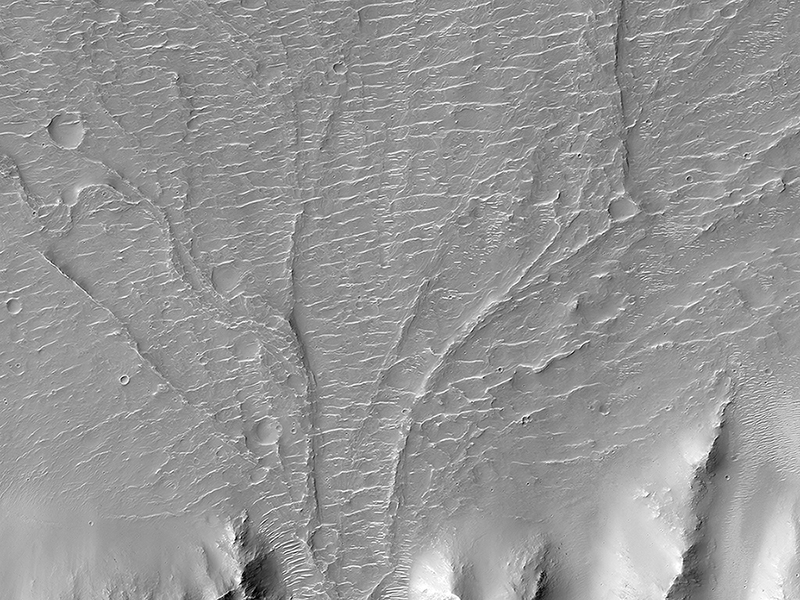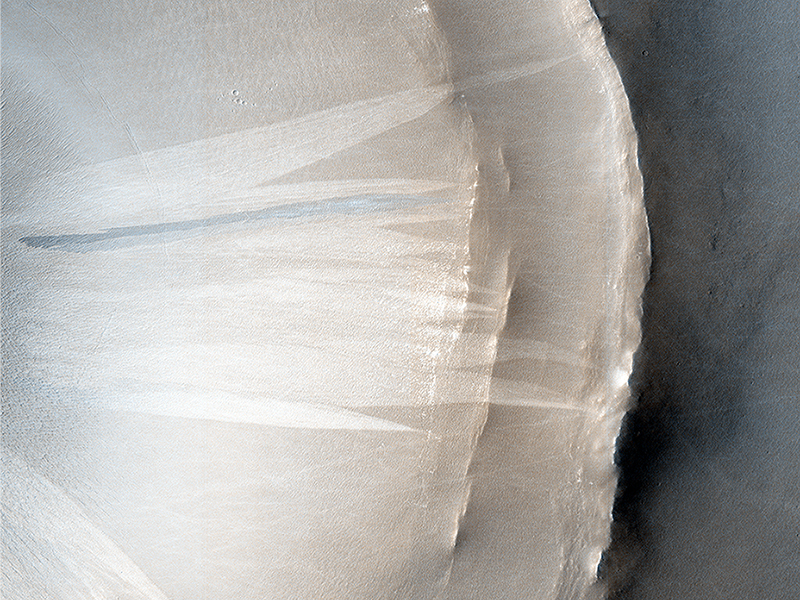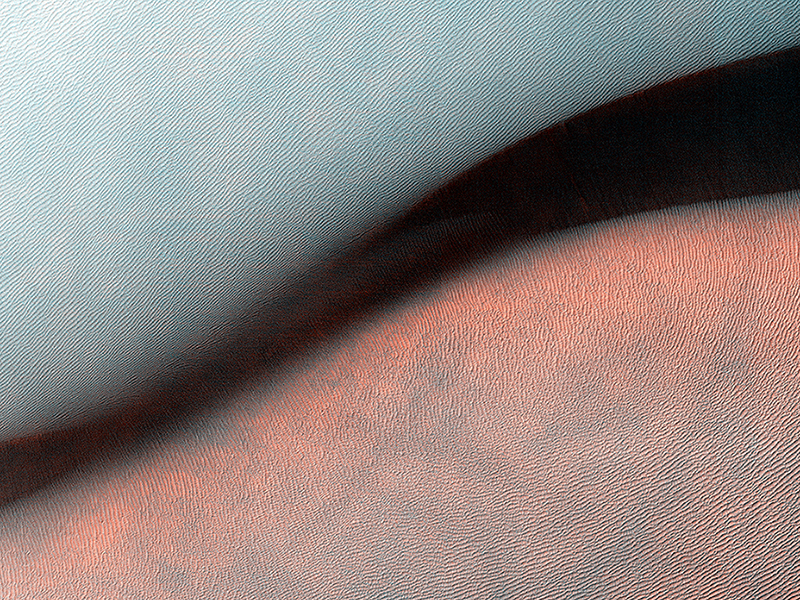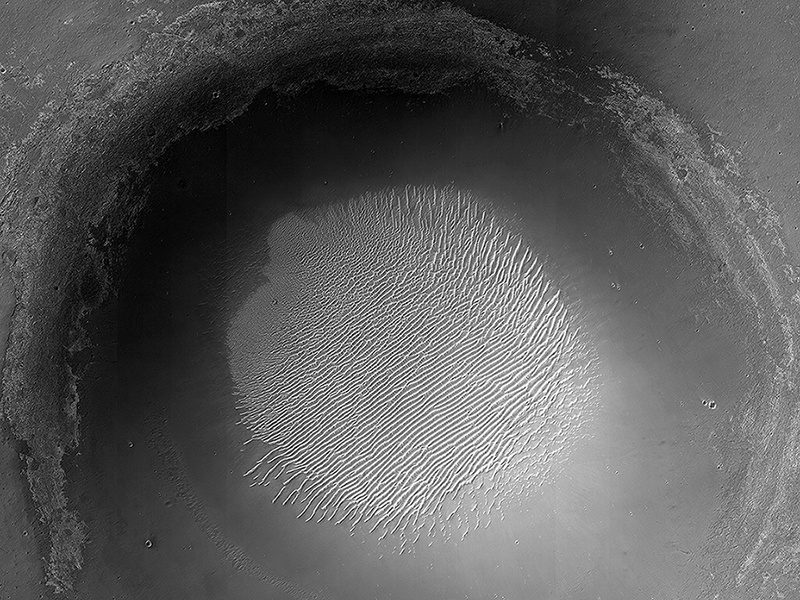HiRISE Targeting Specialists wrote:An Alluvial Fan in a Low-Latitude Crater (ESP_028799_1565) (HiClip)
On Earth, alluvial fans form in desert regions when heavy but sporadic rainfall washes debris from upslope and deposits it in a wedge-shaped fan on the lower slopes below.
On Mars, alluvial fans are sometimes visible in impact crater basins, as material from the steep rims is transported radially inward to the relatively flat floor. Because this is a water-driven process on Earth, and therefore might work the same way on Mars, scientists study Martian alluvial fans order to try to better understand the climate history and possible warmer, wetter past of Mars.
This image, along with its stereo companion, displays an alluvial fan on the floor of a large, 60-kilometer (38 mile) diameter equatorial crater. It is one of several present in the crater (see ESP_017340_1565). This one looks particularly nice in the anaglyph, as there are well-delineated ridges in the fan that stand above the crater floor. These ridges are inverted channels, which form when the floor of a channel is more resistant to erosion than the surrounding surface. This can happen if the floor of the channel is cemented by minerals deposited from water, filled by lava, or simply covered by larger rocks which are hard for the wind to sweep away.
HiRISE Targeting Specialists wrote:Touring a Dusty Region (ESP_034259_2040) (HiClip)
Dusty regions on Mars are often considered to look boring in HiRISE images because the dust obscures surface features. However, new meteor impacts are found most easily in dusty regions such as the one in this image because the new impacts blast away the dust at the surface, leaving obvious dark spots that can be seen in images from the Mars Reconnaissance Orbiter Context Camera (CTX). HiRISE will then take a close up image of the dark spots to image any new craters that have formed as a result of the impact.
As well as confirming a new impact, this image also showed other features commonly found in dusty areas: slope streaks and bed-forms. A close-up picture of the roughly 2.5-kilometer-diameter crater at the bottom of the main image shows ridges on the crater floor where dust has become trapped, and bright and dark streaks down the crater walls where dust has cascaded down the slope.
Matthew Chojnacki wrote:The Draa of Mars (ESP_034909_1755) (HiClip)
Sandy landforms formed by the wind or aeolian bedforms are classified by the wavelength--or length--between crests. On Mars we can observe four classes of bedforms (in order of increasing wavelengths): ripples, transverse aeolian ridges (known as TARs), dunes, and what are called “draa.” All of these are visible in this Juventae Chasma image.
Ripples are the smallest bed forms (less than 20 meters) and can only be observed in high-resolution images acquired by HiRISE commonly superposed on many surfaces. TARs are slightly larger bedforms (wavelengths approximately 20 to 70 meters), which are often light in tone relative to their surroundings. Dark-toned dunes (wavelengths 100 meters to 1 kilometer) are a common landform and many are active today. What geologists call “draa” is the highest-order bedform with largest wavelengths ( greater than 1 kilometer), and is relatively uncommon on Mars.
Here, this giant draa possess steep faces or slip faces several hundreds of meters tall and has lower-order superposed bedforms, such as ripples and dunes. A bedform this size likely formed over thousands of Mars years, probably longer.
Lori Fenton wrote:A Large Crater in Meridiani Planum (ESP_036397_1785) (HiClip)
This crater is located in Meridiani Planum, about 20-kilometers northwest of where the Opportunity rover landed in 2004 (and about 42-kilometers northwest of Endeavour Crater’s rim, where the rover has been busy the past few years). Although it’s in the opposite direction from where the rover went, this crater is still an interesting place.
With a diameter of 4-kilometers, it’s the largest crater in the region other than Endeavour Crater (22 kilometers). It’s also a little more than 5 times larger than Victoria Crater (0.75 km), which Opportunity spent nearly 2 years investigating from 2006-2008 (compare with TRA_000873_1780).
What makes it worth checking out? This crater is much older than Victoria Crater. Compare the smooth, rounded rim of this crater to the jagged edge of Victoria's actively-eroding rim. In comparison with Victoria, this crater is much more filled in by sediments, and its rim is more planed off by erosion. Despite the difference in age and scale, these two craters, and most such craters in Meridiani Planum, have much in common. Both craters have exposed bedrock layers along the rim, a field of bright ripples on the crater floor, and dark sand that has piled up along the north inner crater rim and that extends to the northwest on the plains beyond the crater.
Credit: NASA/JPL/University of Arizona
<< Previous HiRISE Update



